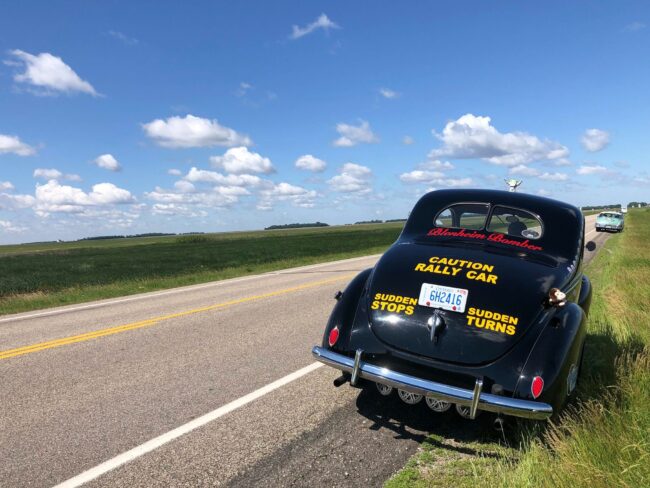Blenheim Bombers Use 2022 Great Race as Experience for the Future
By Thomas Slager/ CandidBadger.com

The Great Race came to a conclusion on June 26 after having covered more than 2000 miles over nine states. The Blenheim Bombers, based in Blenheim, Ontario competed in the event for the third time. Their 1939 Ford Coupe, driven by Wes Thompson with Scott Vidler as the navigator, was also supported by Dave Carruthers and Stan and Jane Uher in the chase team.
The competition is limited to cars built in 1974 and older, which provides an opportunity to see many unique, vintage automobiles, some of which were built as early as 1913. Each morning the teams are given a packet with a written route to drive that contains precise directions and timing. The goal is to arrive at each checkpoint precisely on time. Too early or too late and the team incurs penalties. Penalties are modified based on the age of the car, with older models getting the biggest benefit.
Each day is broken into stages, usually four, and it’s at the end of these stages that the car’s arrival time is measured against a “perfect” time. Teams that manage to score an exact time are said to have achieved an “Ace” which, over the course of a hundred miles or more, is difficult to do. This year, top teams were finishing with stage scores between zero and four seconds off of perfect. All of this is done while facing unique conditions on the roads and in the cars.
Wes Thompson remarked, “I recall the heat and exhaustion playing havoc with my concentration. It’s very busy in the car; the navigator is doing calculations, watching clocks, anticipating the next instruction, and double-checking every conclusion. As a driver, I’m staring at a big speedometer, assessing traffic, and watching for signposts. It’s unrelenting. It’s too easy to get distracted – the car makes a noise, or a hill makes holding speed difficult – then add heat and exhaustion – before I realize it, I’ve misheard an instruction.”
Scott Vidler related the team’s creative solution for rain. “In an old car that does not have a defroster system, and windshield wipers that don’t wipe all that well, we had to use a “Woody” stuffed toy from Toy Story.”
The first day started off well, and the team earned their first “Ace.” Later that day, however, mechanical gremlins struck. Thompson said, “We experienced a “Rapid, Unscheduled, Disassembly” of a 1939 Ford transmission.” This meant two things: a long night of rebuilding the transmission with the help of a local automotive repair shop, and a repair that would cause them to miss their start time and their ability to participate in the second stage. Unfortunately, their attempt at scoring an overall placement for 2022 was at an end.
As disappointing as that was, according to Thompson it highlights the “to finish is to win” mantra of the participants and the best traits of the race teams. “All day long,” he recalled, “it’s very competitive but, at night–in a parking lot–we all help fix any car that needs attention. If a rookie is confused about something, we all try to explain it. At the end of the race, we celebrate our achievements collectively. The desire to get everyone to the finish line is universal.”
The team never considered quitting. Stan and Jane Uher along with Dave Carruthers worked to support the in-car team through mechanical expertise and manning the support truck. “It’s very disheartening to realize we are out of contention,” said Thompson. “Somehow, it never occurred to us to stop trying. In hindsight, when I listen to the team talking, it’s the overcoming adversity they reflect on.”
Referencing the scoring charts from the event, teams that finish in the top five on any particular day usually have to have a time deviation of no more than 10 seconds over the course of nearly 500 miles. This level of precision takes practice.
With only two previous runs in The Great Race, continuing on was important for the experience. After missing the second day, pulling up to the starting line on day three was the best way to improve for future events. Vidler comments, “We are more interested in personal best, fun and the camaraderie with the other rally teams.
“We hadn’t been in the car since 2019,” he explained. “The top competitors will spend many hours in their cars before the rally driving simulated rally courses and performing the speed change and turn actions that are performed. Some will even connect a true rally computer to their car during practice so that they can determine to tenths of a second how much time is lost during maneuvers and create performance charts that are very accurate. Basically, it is “seat time” and it was reflected in our scores improving as the week progressed.”
The race itself is gruelling, with long days spent covering many miles. Keeping focus was often hard. Vidler remarked, “We drove into the heat wave that came across the continent. The flathead V8 produces enough heat on its own but add the high ambient air and it’s a bit sticky in the car.”
The Blenheim Bombers are now looking forward to next year, and possibly entering similar events, some of which are overseas. Thompson says, “As a returning team, we are signed up for next year. However, we are looking into other events. Some are weighted to endurance, and some are considered ‘fast tours’ [with] sporting cars. Vehicle prep and getting everything to the location preclude doing more than one or two events a year.”


